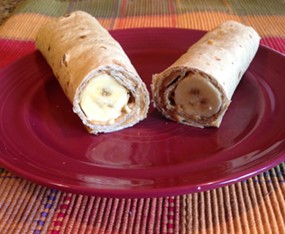Bananas
Benefits of bananas
Being able to grab a banana to go is just one of the many things that makes it a popular fruit in most households. Bananas are also inexpensive and widely available, are a tasty snack, and a low-calorie food. The average sized banana contains about 100 calories and is equal to about 3/4 cup of fruit. Depending on its ripeness, it can contain up to 5 grams of fiber. Bananas also provide plenty of other vitamins and minerals such as potassium, folate, vitamins B2 and B6, and vitamin C.
Buying and storing
- Choose bananas according to the peel color and ripeness desired. Select bananas that are bright yellow for salads or immediate eating
- Use fully ripe bananas, with speckles on the peel for baking, smoothies, or recipes that specify mashed bananas.
- To slow ripening, refrigerate. (The peel will turn black but the fruit inside will be fresh and ripe).
- If bananas are too green, place them in a brown paper bag in a warm, dry area (out of direct sunlight) for a day or two to help ripen. If there is still not enough yellow appearing on the peel, place a ripe apple in the bag with the bananas.
- To freeze bananas, peel and store them in a container or freezer bag until ready to use.
Ways to enjoy bananas
- Serve sliced banana with peanut butter on a whole grain English muffin or whole grain bread.
- Add chopped banana to low-fat yogurt or hot or cold whole grain cereal.
- Add to smoothies or blender drinks. For example: Blend 1/2 cup low-fat milk, 1/2 cup crushed ice, a little sweetener (maple syrup, honey, etc.), 1 frozen, sliced banana, and 1 cup low-fat plain yogurt.
- Make banana "ice cream" by peeling bananas, freezing them in chunks, and blending in a blender or food processor.
- Make banana "popsicles" by freezing halved bananas on popsicle sticks. Then dip in melted chocolate and freeze again.
Featured Recipes
Peanut Butter BananasSpread the entire outside of each banana with peanut butter.Roll the bananas in the crushed nuts.Cut the bananas in 1-inch slices.Serve immediately or store in therefrigerator or freezer until ready to serve. |
|
Peanut Butter Banana RollupsPlace tortilla on a flat surface. Spread peanut butter evenly over the entire wrap.Lay banana onto the lower third portion of the wrap and gently roll it up in the wrap until it is completely covered. press gently to allow the peanut butter to seal the wrap closed. |
 |

 You may require
You may require